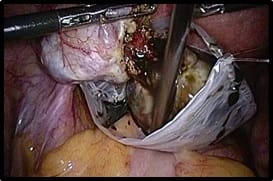Comparative study of Port site infection after gall bladder retrieval using indigenously designed endo-bag and without using endo-bag in Laparoscopic Cholecystectomy.
Vergadia A.1*, Diwakar A.2, Datey A.3
DOI: https://doi.org/10.17511/ijoso.2020.i03.04
1* Ankita Vergadia, Postgraduate Resident, Department of Surgery, Peoples College of Medical Sciences and Research Centre, Bhopal, Madhya Pradesh, India. https://orcid.org/0000-0001-5710-6234
2 Arvind Diwakar, Associate Professor, Department of Surgery, Peoples College of Medical Sciences and Research Centre, Bhopal, Madhya Pradesh, India.
3 Ashirwad Datey, Associate Professor, Department of Surgery, Peoples College of Medical Sciences and Research Centre, Bhopal, Madhya Pradesh, India.
Background: Laparoscopic Cholecystectomy is the most common minimally invasive surgical procedure performed worldwide to remove the diseased gallbladder and also the gold standard in the treatment of symptomatic gallstone. The study aims at assessing the comparative utility of indigenously designed endo-bag for gallbladder specimen extraction to prevent infection of the port site in laparoscopic cholecystectomy by using and without using a bag. Material and Method: This randomized prospective study was conducted on fifty patients included using random sampling. A predesigned and validated proforma was used to record the clinical data. Indigenously designed endo-bag made of the sterile surgical glove was used for gall bladder specimen retrieval and the epigastric port was used as retrieval port. Results: In the present study, 50 patients who underwent surgery only 1 patient was obese with a BMI of 32.38 mg/kg2. The incidence of PSI in patients who underwent the procedure using a bag was 4% whereas it was 8% in patients without a bag. Distribution of appearance of port site infection in relation to various observational days, it was found that patients, where procedure was performed using bag, at day 3 one patient (4%), had PSI. Conclusion: The incidence of infection at the port site was more among the patients where endobag was not used in comparison to those undergoing extraction with endobag.
Keywords: Laparoscopic cholecystectomy, port site infection, endo-bag, gall bladder
| Corresponding Author | How to Cite this Article | To Browse |
|---|---|---|
| , Postgraduate Resident, Department of Surgery, Peoples College of Medical Sciences and Research Centre, Bhopal, Madhya Pradesh, India. Email: |
Vergadia A, Diwakar A, Datey A. Comparative study of Port site infection after gall bladder retrieval using indigenously designed endo-bag and without using endo-bag in Laparoscopic Cholecystectomy.. Surgical Review Int J Surg Trauma Orthoped. 2020;6(3):159-165. Available From https://surgical.medresearch.in/index.php/ijoso/article/view/189 |


 ©
© 